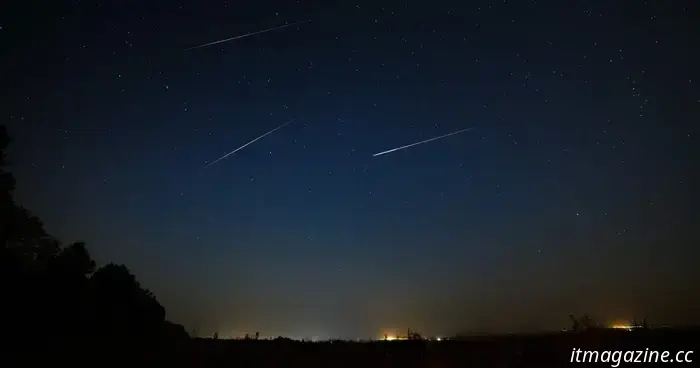
Tips from an expert on how to view the Lyrid meteor shower this weekend.
The Lyrid meteor shower
Next week promises to be exciting for stargazers, with the Lyrid meteor shower expected to be visible over the weekend and reaching its peak on Monday night. If you're eager to experience this delightful cosmic display, Robert Massey, Deputy Executive Director of the Royal Astronomical Society, has provided some tips on how to achieve the best viewing experience no matter where you are.
The Lyrids will be active from April 17 to April 26, peaking on the night of April 21 to 22. Although you won’t see long and bright trails like in other meteor showers, you might catch fleeting flashes known as fireballs.
“With the Lyrids, you can anticipate a brief flurry of short-lived light streaks – often referred to as ‘shooting stars’,” Massey explained in a video. “During the peak of this shower, you might spot around 10 to 15 meteors an hour, so it's not overly prolific… but it's definitely worth it if the sky is clear.”
A meteor shower occurs when Earth travels through a cloud of debris in its orbit, remnants from comets or asteroids. In the case of the Lyrids, the debris originates from the tail of Comet Thatcher, which takes over 400 years to make one complete orbit around the sun and hasn’t approached since 1861. However, the debris it left behind continues to exist, and Earth encounters it once a year, resulting in meteors as these particles burn up in the atmosphere.
For those wanting to see the meteor shower, the northern hemisphere should offer good visibility, as the moon won’t rise until late at night—provided there are no clouds obstructing the view.
“The great thing about a meteor shower— and the Lyrids are no exception— is that special equipment isn't necessary,” Massey added. “The best tools are your eyes gazing at the sky. In this case, the radiant— the point from which they appear to originate— is located in the constellation Lyra, close to the bright star Vega, which is part of the Summer Triangle.
“If you're observing in the early hours of the morning—which is the optimal time—just look up if the sky is clear. The radiant will be somewhat towards the east, but it’s not crucial to focus on a specific direction.”
To maximize your viewing experience, you’ll want to be patient and allow your eyes time to adjust to the darkness. Find a comfortable spot, like a deck chair, with a good sky view, and avoid looking at bright lights, such as your phone, to enhance your night vision.
Georgina has been a space writer at Digital Trends for six years, focusing on human space exploration and planetary topics.
Head out tonight for the chance to see one of three meteor showers
This week is exciting for skywatchers, with three meteor showers occurring simultaneously. If you're in a location with clear skies and away from city lights, venture out after dark for an opportunity to see one of these stunning events. Meteor showers happen regularly as Earth navigates through clouds of debris along its orbit. As it passes through these debris clouds, tiny pieces incinerate in the atmosphere, resulting in the light streaks we know as meteor showers.
Read more
How to watch the Quadrantid meteor shower peak tonight
Tonight marks the peak of the Quadrantid meteor shower, a lesser-known annual event. While it won't be as bright or significant as some of the more recognized showers like the Geminids or the Leonids, it still provides a wonderful reason to go stargazing and welcome the new year. If you're interested in experiencing this event, we have tips for observing the shower in person or an option for watching a livestream for those preferring to enjoy the view from indoors.
What is the Quadrantid meteor shower? An image from the Quadrantid meteor shower. NASA
How to watch the Geminid Meteor Shower this week
This week, the Geminids, one of the best meteor showers of the year, will reach its peak. This annual spectacle occurs when Earth moves through a cloud of debris shed by the asteroid 3200 Phaethon. As this asteroid orbits the sun every 1.4 years, it leaves behind a trail of dust and rock particles that crosses Earth's path. When our planet passes through this debris trail, the rock particles combust in the atmosphere, creating a display of meteors or “shooting stars.”
Meteor showers are enjoyable astronomical events to observe, even for beginners, as they do not require special equipment and can be seen with the naked eye. Below, we have details on how to view the meteor shower in person. If you're not keen on braving the cold, there's also a livestream available where you can enjoy the view from the comfort of your home.
Read more.





Other articles
 NYT Connections: clues and solutions for Thursday, April 17
Connections is the latest puzzle game from the New York Times, and it can be pretty challenging. If you require assistance in solving today's puzzle, we're here to support you.
NYT Connections: clues and solutions for Thursday, April 17
Connections is the latest puzzle game from the New York Times, and it can be pretty challenging. If you require assistance in solving today's puzzle, we're here to support you.
 As AI inundates music platforms, Deezer is taking a stand — in contrast to Spotify.
Deezer has provided an update regarding its initiatives to eliminate AI-generated music, distinguishing the French platform from the streaming leader Spotify.
As AI inundates music platforms, Deezer is taking a stand — in contrast to Spotify.
Deezer has provided an update regarding its initiatives to eliminate AI-generated music, distinguishing the French platform from the streaming leader Spotify.
 NYT Mini Crossword today: answers for the puzzle dated Thursday, April 17.
The NYT Mini crossword may be significantly smaller than a standard crossword, but it's still quite challenging. If you're having trouble with today's puzzle, we have the solutions for you.
NYT Mini Crossword today: answers for the puzzle dated Thursday, April 17.
The NYT Mini crossword may be significantly smaller than a standard crossword, but it's still quite challenging. If you're having trouble with today's puzzle, we have the solutions for you.
 Looking for a 5.1 soundbar? Today, one of Vizio's 2024 Atmos bundles is discounted by $50.
The Vizio 5.1 Soundbar with Wireless Sub (SV510X-0806) is available today at certain retailers for just $200. The original MSRP for this Dolby Atmos bundle is $250.
Looking for a 5.1 soundbar? Today, one of Vizio's 2024 Atmos bundles is discounted by $50.
The Vizio 5.1 Soundbar with Wireless Sub (SV510X-0806) is available today at certain retailers for just $200. The original MSRP for this Dolby Atmos bundle is $250.
 Xpeng unveils its bold global ambitions featuring the X9, an AI chip, a flying car, and a humanoid robot.
Chinese electric vehicle manufacturer Xpeng held the 2025 Xpeng Global Brand Night in Hong Kong on Tuesday. The event highlighted the company's advancements in AI chips, flying cars, and humanoid robots. The Guangzhou-based firm also introduced its first global flagship model, the Xpeng X9, which is a seven-seater multipurpose vehicle.
Xpeng unveils its bold global ambitions featuring the X9, an AI chip, a flying car, and a humanoid robot.
Chinese electric vehicle manufacturer Xpeng held the 2025 Xpeng Global Brand Night in Hong Kong on Tuesday. The event highlighted the company's advancements in AI chips, flying cars, and humanoid robots. The Guangzhou-based firm also introduced its first global flagship model, the Xpeng X9, which is a seven-seater multipurpose vehicle.
 Moto’s Galaxy Z Flip 6 competitor might provide superior performance at a lower price.
Motorola's upcoming foldable flagship might offer better performance than Samsung's Flip series.
Moto’s Galaxy Z Flip 6 competitor might provide superior performance at a lower price.
Motorola's upcoming foldable flagship might offer better performance than Samsung's Flip series.
Tips from an expert on how to view the Lyrid meteor shower this weekend.
A specialist from the Royal Astronomical Society describes how to achieve the optimal view of the Lyrid meteor shower.
